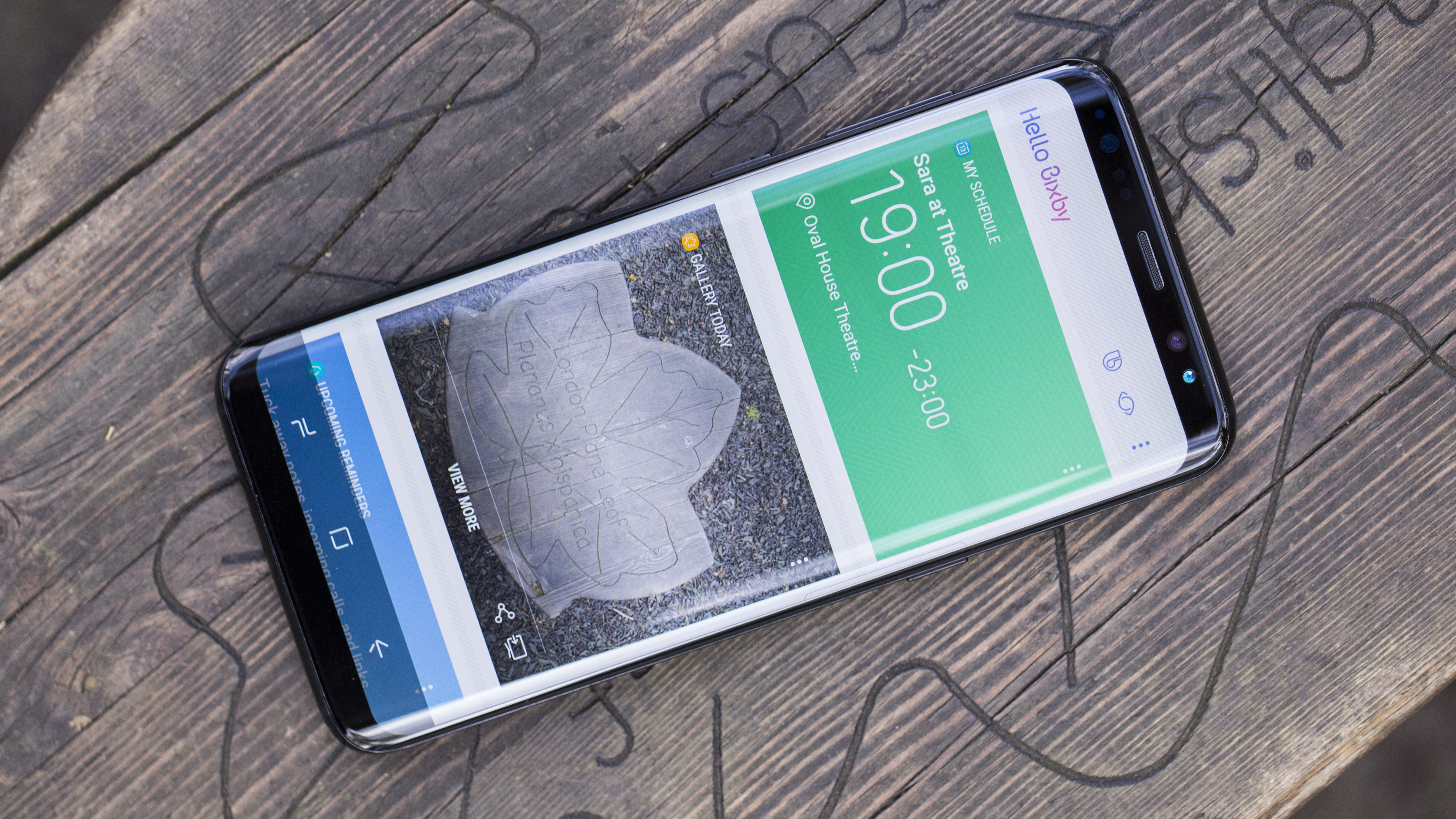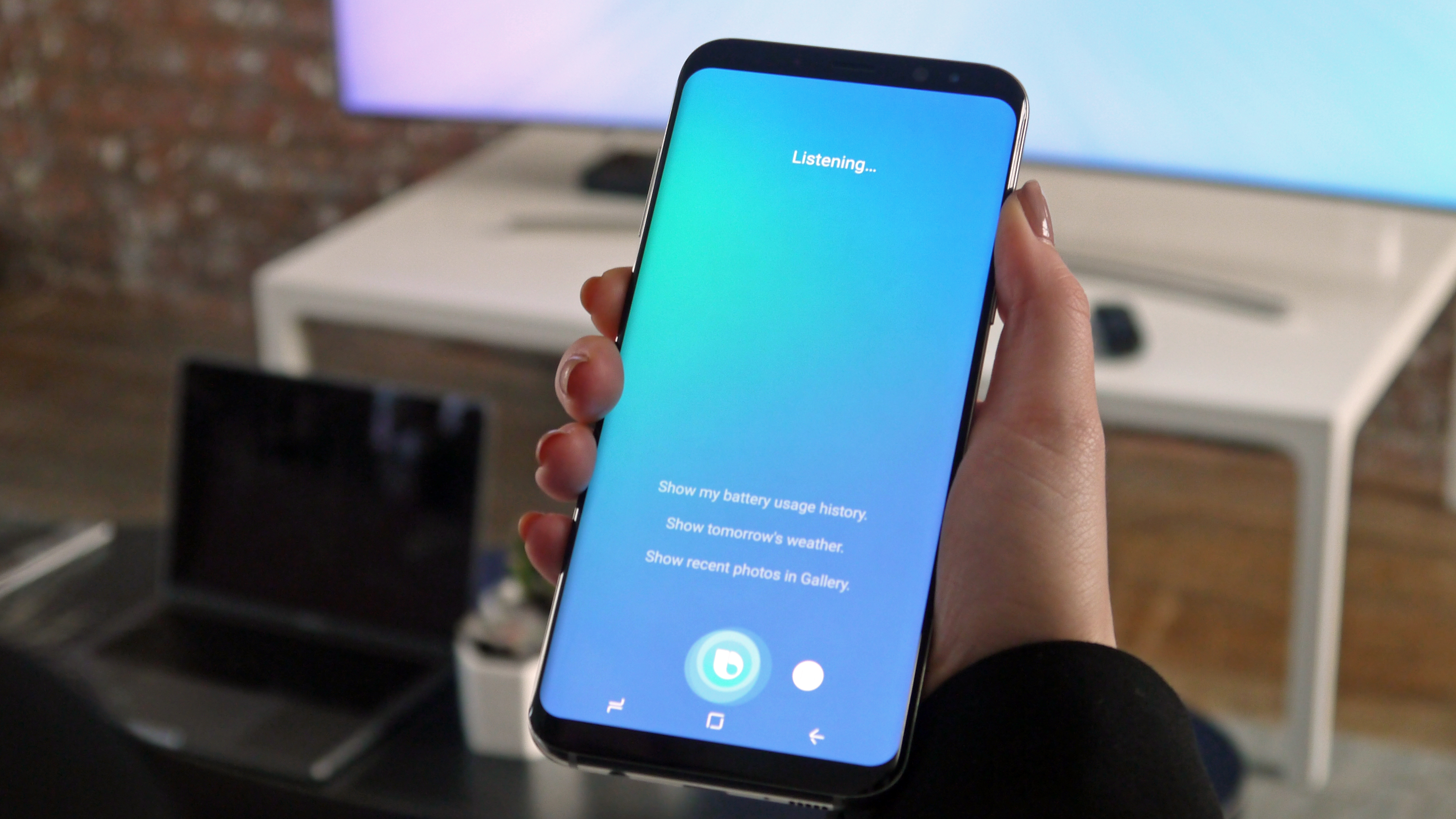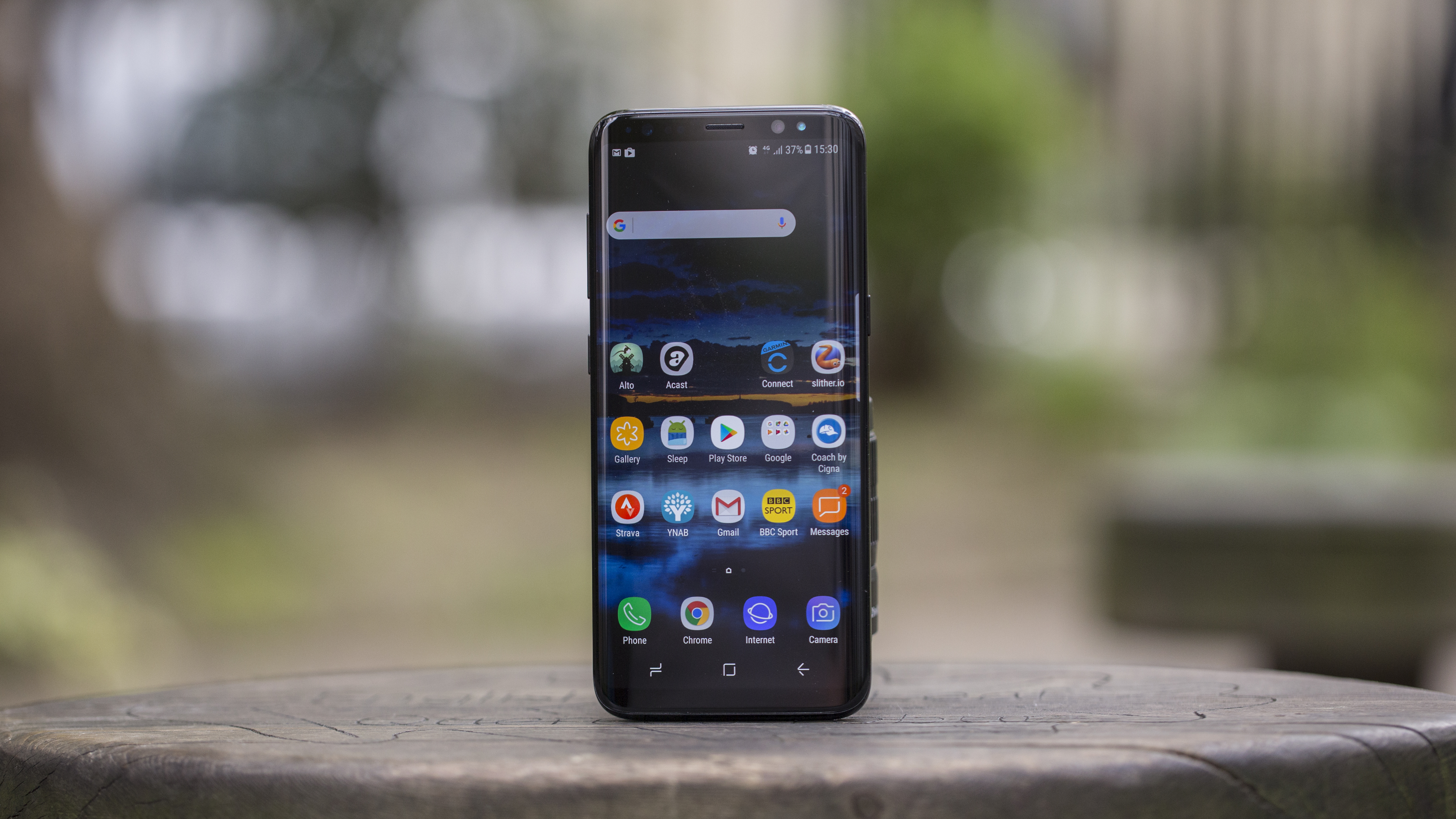TechRadar Verdict
The large, bezel-less display is truly iconic and beautiful, and the screen quality excellent. The fingerprint scanner being placed on the back is a poor decision from Samsung, as well as the iris scanner / facial recognition not working well enough to be a real consideration. However, these aren’t deal breakers, and the improved battery life and tweaked camera will be among the best you’ll find.
Pros
- +
Amazing, large display
- +
Huge power
- +
Great camera
Cons
- -
Irritating biometric unlocking
- -
Very expensive at launch
- -
Bixby pointless
Why you can trust TechRadar
The Samsung Galaxy S8 was something quite special when it launched. It was a phone that was unlike anything we'd seen on the market. And even now, almost two years on, it's still stunning, especially for today's lower price point.
The screen is brilliant - clear, sharp and offers lovely color reproduction to make movie watching a dream, and that's before you've even got to the fact it has a screen larger than the iPhone 8 Plus in a chassis that feels more like the iPhone 8.
Though this is slightly less remarkable now that Apple has fully switched to the all-screen design with all its latest handsets, such as the iPhone XS.
The Galaxy S8 isn't perfect - in the search to squeeze the screen in so completely, other factors were overlooked: namely, the placement of the fingerprint reader. If you want this phone, you'll need to answer this question: are you OK using an iris scanner, one that doesn't always work when you want it to?
And if you're looking for something even bigger, and with a much-improved battery life to boot, then the Galaxy S8 Plus is the way to go - although both have now been replaced by the Samsung Galaxy S9 and Galaxy S9 Plus.
These are iterative upgrades over the S8, so if you want to save some money the now-cheaper S8 is still a great shout, but if you want the very best Samsung has to offer then it's the S9 duo (or the Samsung Galaxy Note 9) that you need to be paying attention to.
Or at this point you might even want to wait for the Samsung Galaxy S10.
Sign up for breaking news, reviews, opinion, top tech deals, and more.
- Read our reviews: Samsung Galaxy S9 | Galaxy S9 Plus
Samsung Galaxy S8 price
- Launch price: $724.99 (£639, AU$1,200)
- Current price: Around $460 (£360, AU$720)
- Release date: April 2017
Weight: 155g
Dimensions: 148.9 x 68.1 x 8mm
OS: Android 8.0
Screen size: 5.8-inch
Resolution: 1440 x 2960
CPU: Snapdragon 835/Exynos 8895
RAM: 4GB
Storage: 64GB
Battery: 3,000mAh
Rear camera: 12MP
Front camera: 8MP
The Samsung Galaxy S8 carried a hefty price tag when it arrived in April 2017, but close to two years on the cost has reduced significantly, making the phone an attractive proposition for those who find the S9 a little on the steep side.
At launch, the SIM-free Samsung Galaxy S8 price was £639 ($724.99, AU$ 1,200), but now it can be found for just around £360 ($460, AU$720). In the US, Amazon has it for $462 unlocked – a $265 price drop in under two years.
In the UK, the contract price has dropped. Some deals offer the phone for less than £25 per month with a substantial amount of internet included. To find the best deal for you, check out our selection of the best Samsung Galaxy S8 deals in the UK.
We spent a week thoroughly testing the Samsung Galaxy S8 when it first came out - watch our video below to see how we got on.
Not seeing eye to eye
- Biometrics add time to unlocking the phone
- Fingerprint scanner in a poor place
- Facial recognition infuriating
Right, let’s get down to business – and we’ll start with the thing that’s concerning us most about the Galaxy S8.
The main issue we have with this phone centers around how you’ll get into it – most smartphones users now expect to use a fingerprint to unlock their device, making it secure and meaning you don’t have to peck in your PIN a billion times a day.
It’s a good idea, it’s safe enough for most people, and it just works – we’re all in agreement there.
With the Galaxy S6, Samsung got biometric unlocking right, but annoyingly with the Galaxy S8 things have become difficult and confusing.
You can unlock this phone with your face, a fingerprint or an iris scan, in increasing order of security level, making the S8 one of the most secure phones around (assuming nobody knows your PIN, of course, which is the backup method of entry).

However, in creating the massive screen on the front of the Galaxy S8, Samsung has moved the fingerprint scanner to the rear of the phone – and placed it out of the reach of most fingers when holding your phone naturally.
As a result, you’ll need to shift the handset to an unnatural position in your palm to reach the scanner with your digit, and thanks to the elongated lozenge-like shape of the fingerprint sensor it can take a couple of attempts to register.
It also makes it less stable in the hand and prone to being dropped. And in terms of it being uncomfortable in the hand, the Galaxy S8 Plus takes it to the next level, with an even harder time of reaching the scanner at the top.
You will find over a few months' use that you'll get used to this - we've found after intensive testing it's not terrible... but it's certainly not optimal.

The fingerprint scanner, then, is too far away to use naturally. So how about iris scanning? Well, it’s the best implementation we’ve seen from Samsung (far better than we’ve seen on the flammable Note 7) but it’s still not perfect.
There are times when it’s flawless, where you’ll just turn the phone on and be instantly unlocked as the S8 has spotted your eyes and confirmed your identity. (Or just thinks you’ve got lovely irises and wants to impress you… either way, it’s rapid).
On the occasions when it works like this you’ll experience a genuine sense of living in the future.

Other times, when you’re walking or in lower light, the iris scanner just failed time and again (although weirdly it works fine in the pitch-dark).
This meant we sometimes ended up gurning (by the way, we urge you to search YouTube for the gurning world championships) at the S8, trying to force the issue by opening our eyes really wide and moving the phone around in order to unlock it.
On the train, this is not acceptable behavior – and after a couple of days, it actually made our eyes hurt, pushing them out on stalks so often.
There were also times when the iris scanner wouldn’t work even in optimal conditions (sitting still in bright light), and only a restart sorted this issue out.
Not smart, Samsung. If you’re going to make people switch to an iris scanner by putting the fingerprint sensor out of reach, then make it flawless, not brilliant-most-of-the-time-but-sometimes-not.
Over a week or so we did get used to the nuances of the iris scanner; it’s fine – it’s just mildly irritating to have to hold your phone in a certain way, and it’s useless while walking or wearing sunglasses (although it did work through regular glasses).

Facial recognition – despite being the default out of the box – is a non-starter for us. The phone fails to recognise your face far too often, it doesn’t work in low light, and it can be spoofed by a photo. Nope, not happening.
There's nothing more infuriating about this feature than the fact you can't see if you're 'positioning' your face correctly. There's definitely an angle to hold it at that's optimal... but you have no idea what it is, or why.
This issue has been increased now that Apple has invested seemingly billions in creating invisible dots that fire into your face to verify your identity the same way... the iPhone X is big competition to the Galaxy S8 as a result.
What users now expect from flagship phones – and what Samsung had done perfectly before – is a simple, muscle memory action that opens your phone. No extra pressing, no having to interact with the phone to open it up – just one single press to be securely into your handset.
The workaround we ended up with (as we’re not leaving our phones unlocked, which is what some might be tempted to do) is to use Smart Lock, where you can set up trusted places or connected devices to confirm your identity.
This means that if you leave your phone lying around at work or at home someone can jump right into it though, so you’re basically just preventing a thief from being able to access data if you lose the Galaxy S8 on the train.
In short, Samsung appears to have screwed this one up. We’d heard rumors that the brand was trying to add in a new feature where the fingerprint was in the same place as on the S7 (at the base of the phone) but actually under the screen.
That would have been perfect, as it’s the way most people fire up the screen anyway. It's a feature that we're now seeing on other phones such as the OnePlus 6T, and which is rumored for the Samsung Galaxy S10.
But clearly Samsung couldn’t make this work effectively on the S8, so decided to shove the fingerprint scanner way up the back of the S8, as that was the only place left to put it that didn’t require some last-minute retooling of the phone.
That's the only logical explanation, as otherwise why wouldn’t the fingerprint scanner be above the Samsung logo, which would be a perfect place for it?
A sluggish start for Bixby
- Bixby still fails to impress
- Very much a future feature
- Bixby Vision adds unnecessary bloat to the camera
The other big feature that’s launched with the Samsung Galaxy S8 is Bixby, the brand’s voice assistant rival to Apple's Siri, Amazon's Alexa and Google's less-interestingly-named Assistant.
Those who've used the Galaxy S3 and S4 will remember that Samsung already tried to match Siri with S Voice, but it was a bit pointless, especially when Google's voice chops got so gosh-darn good.
Well, Bixby is Samsung’s big play in its bid to compete in the arena of artificially intelligent assistants, and it clearly thinks it can succeed despite being so late to the game.

The aim here is to make Bixby an indispensable accompaniment to your daily life, reminding you of things when you need them, letting you know what you're looking at, and being a single-button one-stop shop for all the information you need.
In fact Samsung is so confident that Bixby is going to be brilliant that it's popped a button dedicated solely to this function on the side of the phone.
Yep, a phone that's so tightly designed that it can't even have the fingerprint scanner in an accessible place has a whole key dedicated to Bixby… and it's very hard to see why right now.
Bixby is pretty mundane though, despite having voice functionality added in now, especially as it's inherently inaccurate for voice.
We tested for a while, but as it can't support many third party apps or properly understand what's being said it seems a bit futile. It will probably get better over time, but most people won't care about that.

So what does Bixby mean to you, the new phone buyer? Well, nothing. It's average at best, and pretty much useless at worst.
Bixby Vision, a little icon that lives in the corner of the camera, will be able to analyze what's being shown through the camera's viewfinder (both live and from a taken pic) and let you know whether you can buy it, recognize the image and given information or let you know about a place you're checking out.

Except the results of image recognition just show you things on Pinterest, the shopping element seems to recognize almost nothing at launch and the places option is pretty patchy. It's slow to work out what it’s looking at and, overall, it’s just a waste of screen right now.
Bixby Home, the screen that lives to the side of the home screen, is much better.
It's contextual and interesting, and you can pin your favorite elements (like Spotify, for instance) to the top for easy access from anywhere in the phone.
It's nothing earth-shattering, but it's pretty neat – although there is a maddening pause every time you open it for the first time, as if Bixby is trying to remember where it left its home page.
The good news is you can disable the Bixby button from opening the Home screen, which is great as so many times we hit it instead of the volume key. It's a poor placement.
And then there's Bixby Reminders, where you'll be alerted to things you've made a note of in the past. You can set a location trigger to remind you to buy fruit when you pass a location, or ping you at a certain time to remind you to call someone.
None of this is exactly new though, and there's absolutely no reason why you'd buy the Samsung Galaxy S8 for Bixby.
Samsung is pretty jazzed about Bixby, and the fact that it'll be able to understand things contextually in the future. Right now it only can work with a handful of native apps (not even all of them...) and there’s no interaction with third-party options. But from this acorn, Samsung insists, a mighty oak will grow.
Imagine not just being able to set a location to buy fruit, but being pinged when somewhere nearby sells it. Or taking a picture of something and finding it far cheaper online straight away, or being able to ask your phone to do things contextually (for instance: ‘Bixby, can you turn on the heating when I’m twenty minutes from home?’ ‘Bixby, upload those pictures from my run today to Facebook with the caption ‘#blessed #squadgoals #ImsorryforwhoI’vebecome).
That's the world Samsung is promising, and if you purchase the S8 you'll be buying into that promise. However, right now, that's all it is... and there’s no way we can recommend a phone based on a promise, as Samsung could just pull the plug on a feature like Bixby if it really can't get it to work properly, and a few months on we've seen nothing that suggests it's going to conquer the world of AI.
- Get the best deal on your next Samsung purchase with our Samsung coupon codes.

Gareth has been part of the consumer technology world in a career spanning three decades. He started life as a staff writer on the fledgling TechRadar, and has grew with the site (primarily as phones, tablets and wearables editor) until becoming Global Editor in Chief in 2018. Gareth has written over 4,000 articles for TechRadar, has contributed expert insight to a number of other publications, chaired panels on zeitgeist technologies, presented at the Gadget Show Live as well as representing the brand on TV and radio for multiple channels including Sky, BBC, ITV and Al-Jazeera. Passionate about fitness, he can bore anyone rigid about stress management, sleep tracking, heart rate variance as well as bemoaning something about the latest iPhone, Galaxy or OLED TV.
